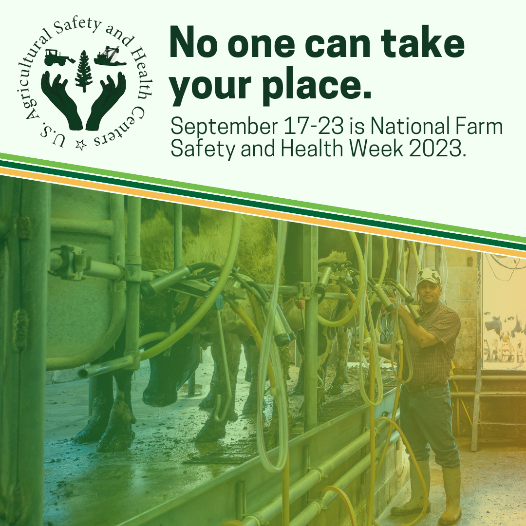National Farm Safety and Health Week: No One Can Take Your Place
For many areas of the country, the fall harvest season is one of the busiest, but also one of the most dangerous for our nation’s farmers and farm workers. Data from the U.S. Bureau of Labor Statistics shows the agriculture industry is consistently at the highest risk for occupational injuries and fatalities, with 453 fatalities in 2021, or an equivalent of 19.5 deaths per 100,000 workers. Farming is also one of the few industries in which family members, including children, are also at risk for fatal and nonfatal injuries.
Join CDC’s National Institute for Occupational Safety and Health (NIOSH) in recognizing the contributions of our nation’s agriculture workers by learning more about the hazards farmers and farm workers face every day, as well as illness and injury prevention efforts for this critical workforce.
Safety and health facts and resources for farm workers
- Roadway crashes that involve farm equipment are 5 times more likely to end with a fatality, but proper signage, lights, and reflective safety strips can help farmers stay visible on rural roads.
- Regularly eating a wide variety of foods can give workers the fuel they need to get things done on the farm. Take a pit stop to eat well to stay well.
- Farmworkers come from many different cultural and language backgrounds. Training materials should have culturally appropriate, innovative, and accessible approaches to share health information with all farm workers.
- One in three farmers are over 65-years-old. The impacts of aging can make hazardous agricultural work even more dangerous, but innovative projects are working to make aging easier and safer on the farm.
- Over half of people who get trapped in a grain bin do not come out alive. Learn more about the risks of working with grain and precautions farm workers can use to stay safe.
What NIOSH is doing
NIOSH is committed to preventing work-related injuries and illnesses among U.S. agricultural workers.
NIOSH has an extensive Agriculture, Forestry and Fishing (AgFF) Research Program, which works to reduce the high risks of injuries and illnesses experienced by workers in this industry.
NIOSH also supports extramural research and prevention programs including 11 regional Centers for Agricultural Safety and Health and the National Children’s Center for Rural and Agriculture Health and Safety. (Ag Centers). These Centers conduct research on injuries associated with agriculture, as well as pesticide exposure, respiratory health, musculoskeletal disorders, underserved populations, and mental health. These Centers provide an array of trainings and resources, as well as expertise to various public interest and policy groups.
Check out the links below for more on the NIOSH AgFF program and other NIOSH-related resources:

September 17-23, 2023 is National Farm Safety and Health Week
NIOSH and its Centers for Agricultural Safety and Health (Ag Centers) are recognizing National Farm Safety and Health Week.
This week emphasizes the importance of working together to prevent injuries and illnesses among agricultural workers.
The Ag Centers have developed a toolkit to promote and provide safety resources aligned with the daily themes of National Farm Safety and Health Week 2023.
Learn more about the toolkit and National Farm Safety and Health Week.
#NFSHW23
Additional National Farm Safety and Health Week resources
